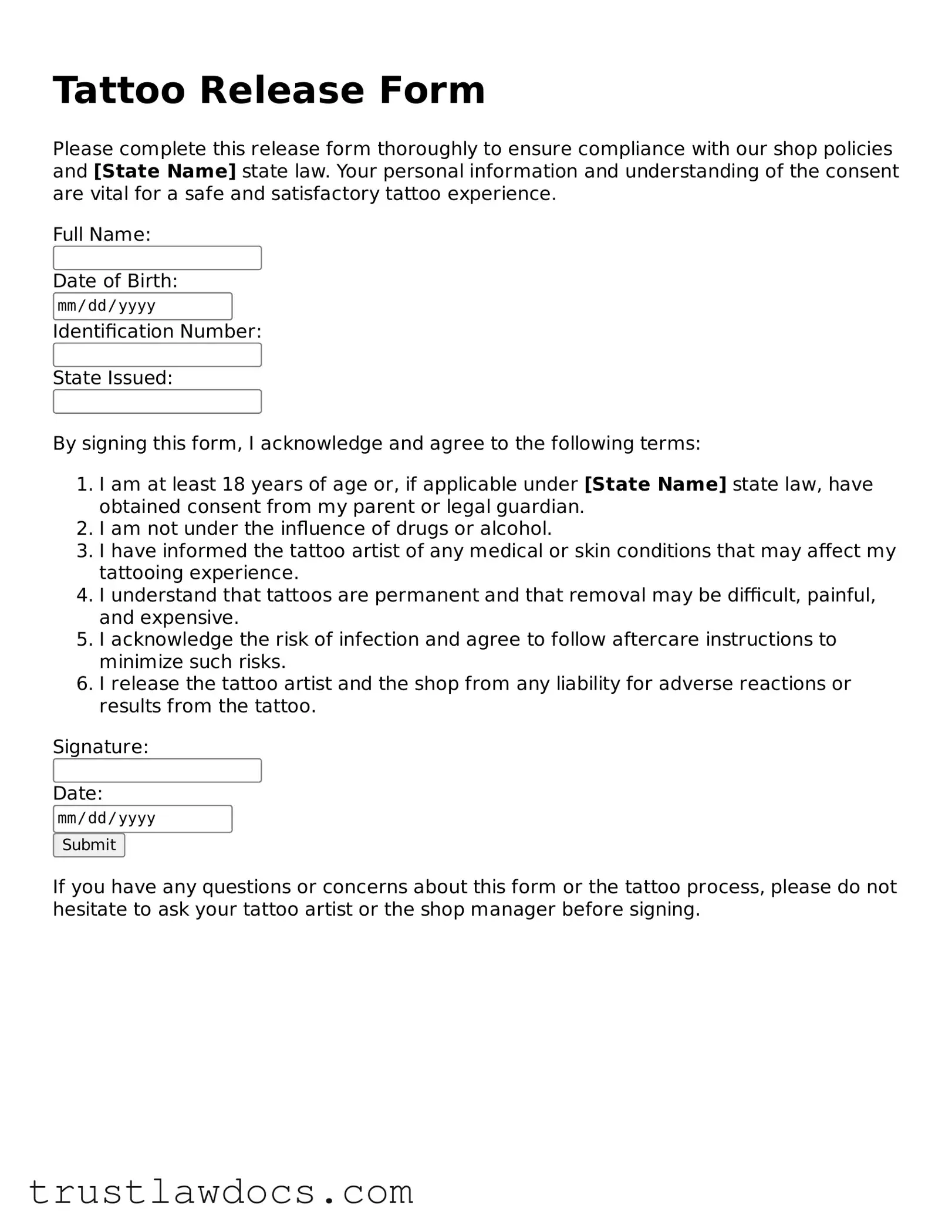What is a Tattoo Release Form?
A Tattoo Release Form is a crucial document utilized in the tattoo industry that both the client receiving the tattoo and the artist or tattoo studio must sign before any tattooing procedure begins. It typically outlines the agreement between the two parties, covering consent to the tattoo process, acknowledgment of the risks involved, and compliance with the studio's policies. It often also includes health and safety information to ensure the adherence to best practices in tattoo application.
Why do I need to sign a Tattoo Release Form?
Signing a Tattoo Release Form is necessary for several reasons. Primarily, it serves as a legal acknowledgment that you have been fully informed about and understand the risks associated with getting a tattoo, such as potential infections or allergic reactions. Moreover, it confirms that you are of legal age to receive a tattoo and consent to the procedure voluntarily. It protects both you and the tattoo artist legally, making clear that the process has been explained and agreed upon by both parties.
What information is typically included on a Tattoo Release Form?
While the specifics can vary, most Tattoo Release Forms will include basic personal information about the client (such as name, address, and age), a section detailing the risks and possible side effects of getting a tattoo, an area where the client acknowledges their consent, and sometimes a portion relating to the care of the tattoo afterward. It's also common for these forms to include a clause where the client releases the artist or studio from liability should any issues arise post-procedure, assuming all guidance was properly followed.
Am I eligible to sign a Tattoo Release Form?
Eligibility to sign a Tattoo Release Form generally requires that you are of the legal age to receive a tattoo in your jurisdiction—usually 18 years old. However, some regions may allow tattoos for younger individuals with parental consent. It's also important that you are in a sober state, as most reputable tattoo studios will not tattoo someone under the influence of drugs or alcohol due to the impact on decision-making and consent.
Can I withdraw my consent after signing the Tattoo Release Form?
Yes, you can withdraw your consent after signing the form and before the tattoo procedure starts. However, depending on the policy of the tattoo studio, you might still be responsible for any fees or deposits paid. Once the tattooing process has begun, it becomes more complicated to address cessation of the work, as it involves the mutual agreement between you and the artist regarding the outcome and any compensation.
What happens if I refuse to sign the Tattoo Release Form?
If you refuse to sign the Tattoo Release Form, the tattoo artist or studio has the right to refuse service. This form is a standard requirement in the industry meant to protect both the client and the artist. It ensures that all parties are informed and agree to the conditions under which the tattooing will occur. Without such an agreement, most professionals will not proceed with the procedure.
Is the Tattoo Release Form legally binding?
Yes, the Tattoo Release Form is a legally binding document once signed by both parties. It serves as a written agreement that you have been informed of and understand the risks associated with tattooing, and agree to proceed under those conditions. This form can be used in legal settings to prove consent and knowledge of the procedure's risks and aftercare requirements.
What should I do if I have concerns about the content of the Tattoo Release Form?
If you have any concerns or questions about the content of the Tattoo Release Form, it's important to address them before signing. Speak directly with the tattoo artist or a representative of the tattoo studio to clarify any points you're unsure about. It's crucial that you fully understand and agree to all terms outlined in the form to ensure a smooth tattooing experience. If certain clauses make you uncomfortable or you feel your concerns are not being adequately addressed, you may wish to consider finding another artist or studio that better aligns with your comfort level and expectations.
